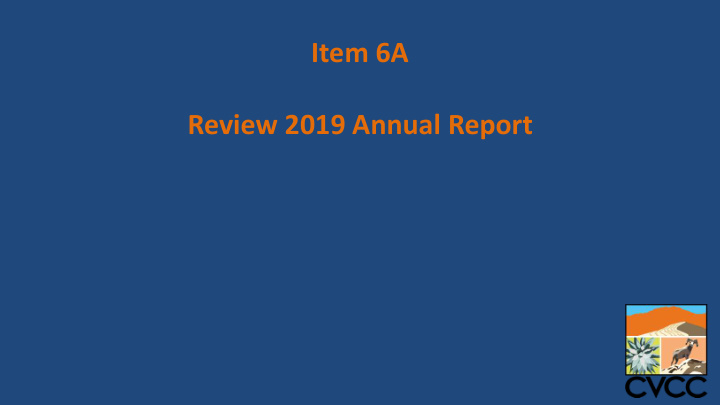



Item 6A Review 2019 Annual Report
A Successful Conservation Partnership • CVCC goal = conserve 4,850 acres by now • 11,717 acres conserved! • Overall goal = 209,740 acres • Together, all partners have conserved 96,043 acres
The Regional Perspective is Key
Conserving the Desert’s Natural Heritage Long-term conservation (75 year permit) which: Protects: ✓ 27 plant and animal species ✓ 27 natural communities ▪ desert fan palm oasis ▪ desert dry wash woodland ✓ 1986 Coachella Valley Fringe-toed Lizard HCP included
Participating Agencies Permittees under the CVMSHCP : • Nine cities – Cathedral City, Coachella, Desert Hot Springs , Indian Wells, Indio, La Quinta, Palm Desert, Palm Springs, Rancho Mirage + Riverside County • Coachella Valley Water District • Imperial Irrigation District • Mission Springs Water District • Caltrans – California Department of Transportation • Coachella Valley Mountains Conservancy • California State Parks Other Partners: • BLM • California Department of Fish and Wildlife • National Park Service • U.S. Fish and Wildlife Service • U.S. Forest Service • Non-profit Conservation Groups
Funding Several sources: • Developer Impact Fees = $5,911 / acre - $1,331 / single-family home • Landfill Tipping Fees • Regional infrastructure contributions Including: • Land acquisition funding, front-loaded with over $30 million from CVAG, Caltrans, CVWD and IID • Acquisition partnerships leverage funding in early years • Endowment for monitoring and land management in perpetuity
Coachella Valley Fringe-toed Lizard Habitat Conservation Plan - 1986
Conservation Areas • Hardline boundaries • Strict limits (10%) on developable acres • 1996 is baseline year • 90%+ of Conservation Areas are in Riverside County • County adopted policy on development
The Coachella Valley Sand System Venturi Effect Winds
The Coachella Valley Sand System
The Coachella Valley Sand System
The Coachella Valley Sand System
A Sea of Sand
Coachella Valley Fringe-toed Lizard
Coachella Valley Fringe-toed Lizard
1. Conserve Habitat Coachella Valley Milkvetch
2. Conserve Essential Ecological Processes such as Sand Transport System
3. Conserve Biological Corridors and Linkages Major Southern California Wildlife Linkages
CVMSHCP Biological Corridors & Linkages
Conserving the Desert’s Natural Heritage Significant Actions in 2019: ➢ Fee collection was up 200% over 2018 ➢ CVCC acquires 391 acres
Conserving the Desert’s Natural Heritage Significant Actions in 2019: ▪ 1,125 acres conserved ▪ 0 acres disturbance ▪ 391 acres credited to CVCC ▪ $1,945,825 in CVCC funds ▪ 224 acres credited to State/Fed ▪ Friends of the Desert Mountains acquired 220 acres with $88,456 in funds from Coachella Valley Mountains Conservancy (CVMC). They also acquired 40 acres with $19,000 from the Resources Legacy Fund Foundation (RLFF). ▪ Snow Creek where CVCC acquired 4 parcels totaling 479 acres with $964,305 in matching funds from Coachella Valley Mountains Conservancy, along with $1,790,695 from Federal Endangered Species Act Section 6 Funds. ▪ 510 acres Complementary (anything other than CVCC or State/Fed)
Progress Toward Land Acquisition Goals
CVCC Credit
State & Federal Credit
Complementary Credit
CVCC Credit State & Federal Credit Complementary Credit
Biological Monitoring
Land Improvement and Management Activities for 2019 • Removed tamarisk from the Willow Hole Conservation Area. • Removed patch of Athel tamarisk threatening mesquite water source • Installed 8,610 linear feet of post and cable fencing • Received Proposition 1 funds for “Wetlands Restoration, Tamarisk Removal, and Rail Habitat Enhancement” at North Shore Ranch
Item 6A RECOMMENDATION: Review and Accept the 2019 Annual Report on the Coachella Valley Multiple Species Habitat Conservation Plan and Provide for Public Input
Recommend
More recommend